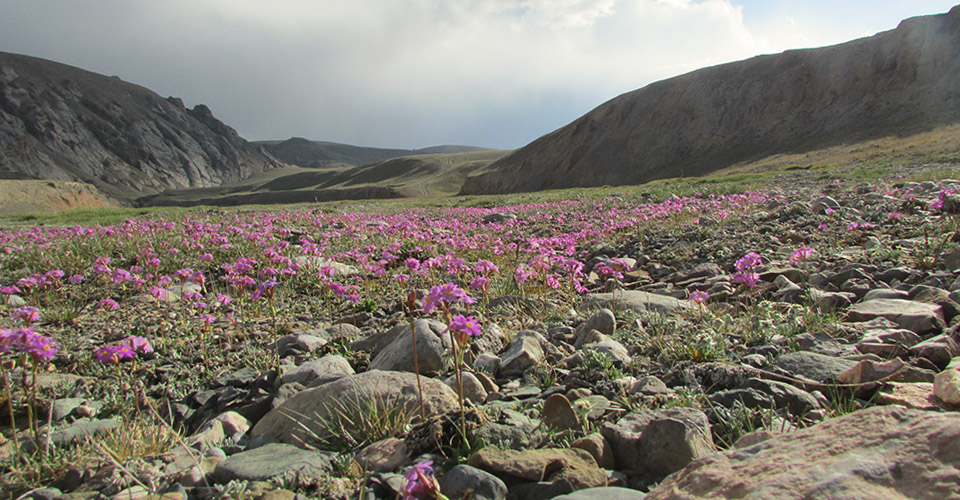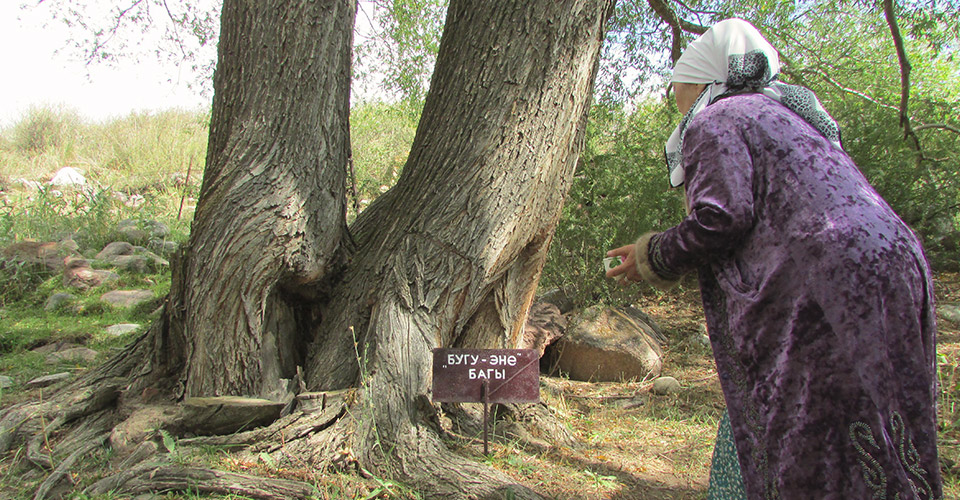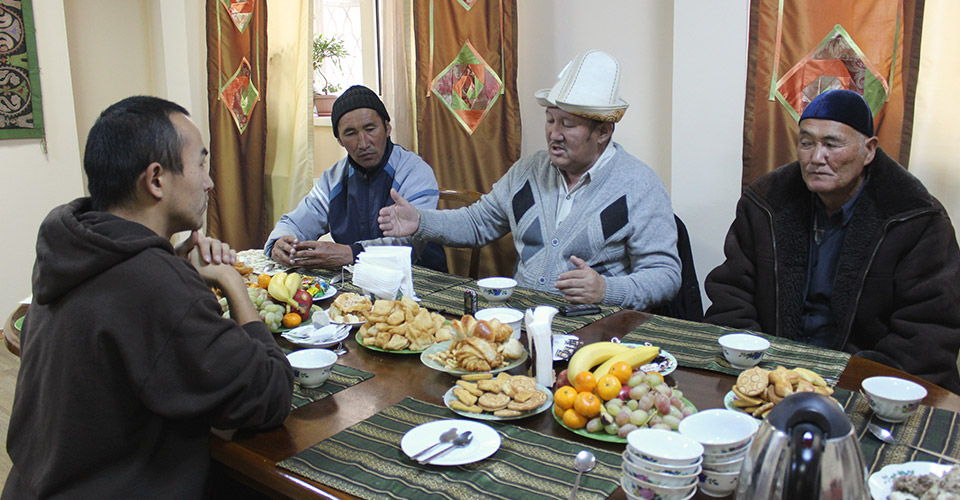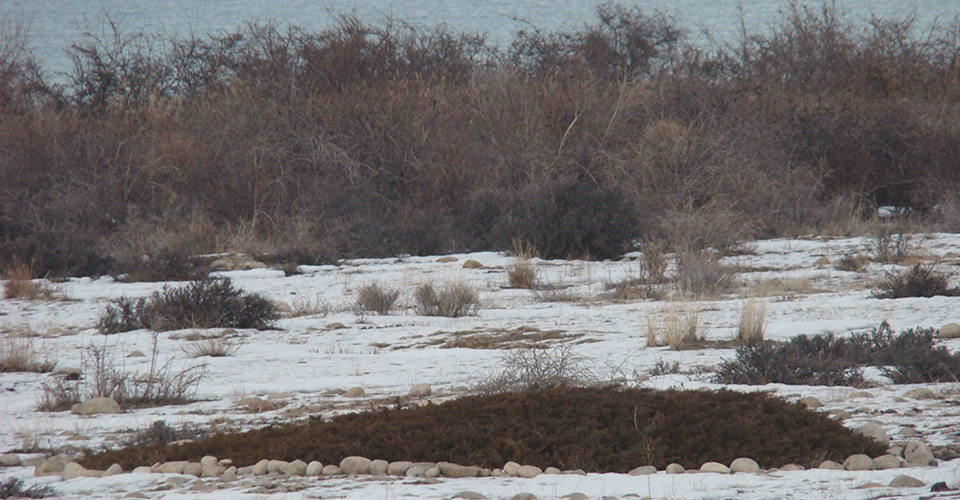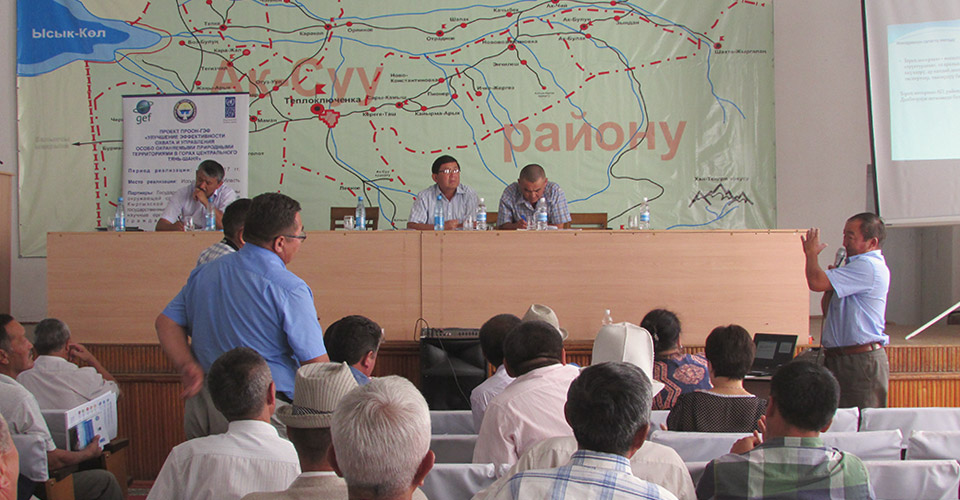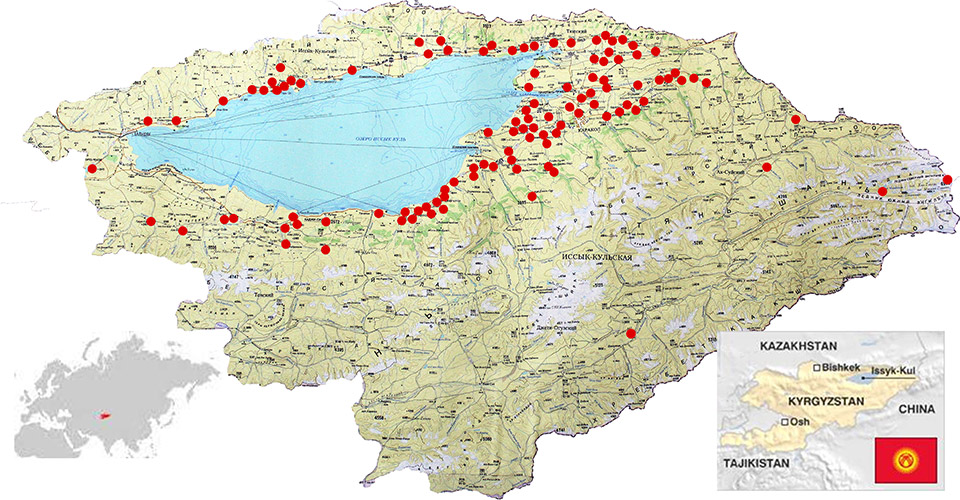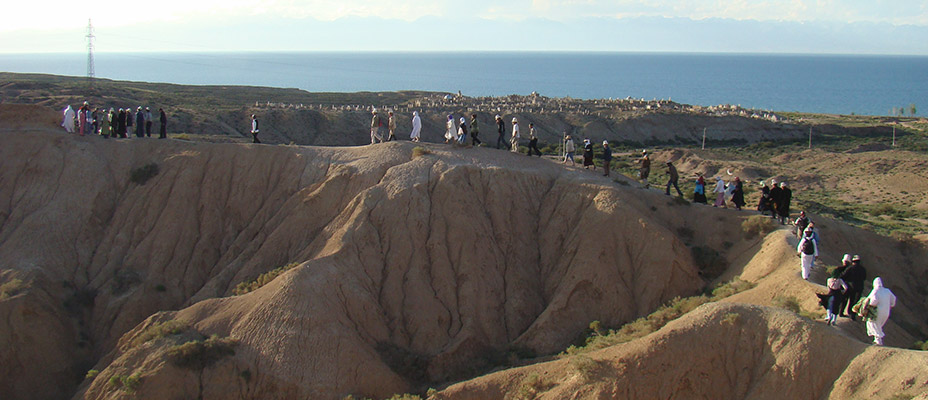जागा
किर्गिस्तानच्या ईशान्य पूर्वेकडील इसिसक कुल प्रांताच्या हाईलँड्समध्ये जगातील सर्वात मोठ्या उन्नत पाण्याच्या खो ins ्यांपैकी एक आहे. टेकड्यांमधून त्याच्या आकारामुळे, स्थानिक लोकांचा असा विश्वास आहे की हे पृथ्वीचे आध्यात्मिक ‘तिसरे डोळा’ आहे. बायोस्फीअर रिझर्व म्हणून, हे राष्ट्रीय सरकारच्या संरक्षणाखाली आहे, स्थानिक रहिवासी काळजी घेतात 130 प्रदेशातील पवित्र साइट. स्थानिक संरक्षित पवित्र नैसर्गिक साइट्स वैयक्तिक झाडे असू शकतात, माउंटन पीक्स, लँडस्केपमधील पाणी आणि इतर घटक. वैज्ञानिक संवर्धन आणि स्थानिक संवर्धनाची उद्दीष्टे आणि पद्धती नेहमीच सुसंगत नसतात, आणि सध्याच्या परिस्थितीत समुदाय आणि व्यवस्थापक यांच्यातील विश्वास एक आव्हान आहे.
धमक्या
स्थानिक गावकरी तलावाचे खाण आणि सांडपाणी प्रदूषण महत्त्वपूर्ण धोके म्हणून समजतात. प्राचीन विद्या नंतर, काहींनी अशी अपेक्षा केली आहे की लेक कोस्टचे प्रदूषण आणि खाजगीकरण या दोहोंमुळे आध्यात्मिक आपत्ती उद्भवू शकते. स्थानिक विश्वासांनुसार, जर समुदायांनी त्यांच्या वातावरणाचा गैरवापर केला तर, निसर्ग तो बदला घेईल. शिकार करणे आणि जैवविविधतेचे नुकसान म्हणजे जीओएस आणि स्वयंसेवी संस्थांनी तसेच पवित्र साइट कस्टोडियन लोकांकडून अतिरिक्त धोके सोडले आहेत..
एकत्र काम
बायोस्फीअर रिझर्व्हमध्ये अनेक संवर्धन कलाकार आहेत, त्यापैकी काही औपचारिकपणे, इतर आपले कार्य अनौपचारिक मार्गाने करतात. मॅनिटोबा विद्यापीठाचा अभ्यास, समुदाय संवर्धन संशोधन नेटवर्कद्वारे समर्थित असे सूचित करते की पारंपारिक संरक्षक आणि बाह्य पक्षांचे प्रयत्न केवळ संवाद साधतात, आणि हे गट बर्याचदा एकमेकांच्या दृष्टिकोन आणि क्रियाकलापांविषयी माहिती नसतात. हे व्यक्त केले आहे, उदाहरणार्थ, बायोस्फीअरचे कर्मचारी पैसे गोळा करण्यात चांगले आहेत असा विश्वास असलेल्या गावक in ्यांमध्ये, पण शिकार थांबविण्यात वाईट. तेथे काही स्थानिक अपवाद आहेत, जेथे सरकारी संस्था, स्वयंसेवी संस्था आणि समुदाय एकाच प्रकल्पात एकत्र काम करतात.
परिस्थिती विज्ञान आणि जैवविविधता
रखरखीत प्रदेशात स्थित लेक इसिक कुल एक उंच उंचीची गोड्या पाण्यातील खोरे आहे. हे अल्पाइन आणि सबलपाइन कुरणांसह वसंत to तु ते विविध जीवन फॉर्म म्हणून कार्य करते, हाय माउंटन टुंड्रा, रिव्हरिन इकोसिस्टम, मासे आणि अनेक सस्तन प्राणी जसे की धोकादायक मार्को पोलो मेंढी (ओव्हिस अम्मोन पॉली), सायबेरियन आयबेक्स (Sibyric) आणि प्रतीकात्मक बर्फ बिबट्या (असभ्य अनिया). रिझर्वमधील काही प्रजाती आययूसीएन लाल यादीमध्ये आहेत.
पवित्र साइट्स आणि त्यांच्या संरक्षकांचे स्वरूप
पवित्र नैसर्गिक साइट्सचे इसिक कुलमधील स्थानिक लोकांसाठी महत्त्वपूर्ण अर्थ आहेत. त्यांच्या समाजात, विशेषत: मूल्यवान घटक म्हणजे अर्ध्या कोरड्या वातावरणासारख्या अनपेक्षित ठिकाणी आढळणारी झाडे आहेत. किंवा समजल्या जाणार्या पवित्र नैसर्गिक साइट्स विशिष्ट स्प्रिंग्स आहेत, भौगोलिक रचना आणि संपूर्ण इकोसिस्टम जसे की इसिक कुल लेक स्वतःच. जेव्हा एखाद्या व्यक्तीस रोजीरोटीची गरज असते (मुले, आरोग्य किंवा आध्यात्मिक कल्याण), तो किंवा ती एका विशिष्ट पवित्र साइटला भेट देते. Lore हे शिकवते की तीर्थक्षेत्राच्या यशाची डिग्री एखाद्या साइटच्या पवित्रतेशी संपर्क साधण्याच्या त्याच्या क्षमतेवर अवलंबून असते. इसिसक कुल लेकच्या सभोवतालच्या पवित्र नैसर्गिक साइट्सची स्वतःची स्वयं-नियुक्त आणि समुदाय-मान्यताप्राप्त पालक आहेत. काही बाबतीत, स्थानिक आध्यात्मिक चिकित्सकांना पवित्र नैसर्गिक साइटवरून स्वप्नातील संदेश मिळतात, ज्यांचा त्यांचा विश्वास आहे की आजारी पडणा people ्या लोकांना बरे करण्यास मदत करा. या साइटचे नुकसान करणार्या लोकांसाठी आजारांसारख्या आध्यात्मिक शिक्षेवरही समुदाय विश्वास ठेवतात.
दृष्टी
औपचारिक संवर्धन आणि समुदाय-आधारित पवित्र साइटची उद्दीष्टे सुसंगत असू शकतात. म्हणून, या प्रदेशासाठी एक दृष्टी अशी आहे की गुंतलेल्या पक्षांमध्ये ट्रस्ट बिल्डिंगचा संपूर्ण फायदा होईल. जर त्यांनी स्थानिक समुदायांचे पारंपारिक पर्यावरणीय ज्ञान वापरले तर जीओएस आणि स्वयंसेवी संस्थांचे औपचारिक संवर्धन अधिक प्रभावी होईल; बदल्यात, जीओएस आणि स्वयंसेवी संस्थांच्या संघटनात्मक क्षमतेमुळे समुदायांना फायदा होऊ शकेल. संशोधकांनी तळाची शिफारस केली, पवित्र साइट-केंद्रित, आणि जैव सांस्कृतिक दृष्टीकोन, जेथे समुदाय सदस्य, पालक आणि पार्क व्यवस्थापक एकमेकांना ओळखतात आणि एकमेकांना त्यांचे कौशल्य शिकवतात आणि दृष्टी सामायिक करतात.
"मी एक आयन पाहिले (स्वप्न) ज्यामध्ये एक पवित्र साइट मला कॉल करीत होती. ते म्हणाले की ते प्रदूषित आणि दुर्लक्ष केले जात आहे. मी सकाळी उठलो आणि त्या साइट शोधण्यासाठी निघालो. ते कोठे आहे हे मला माहित नव्हते. मी स्वप्नात पाहिल्याप्रमाणे हे कसे दिसते हे मला माहित होते. मी डझनभर गावातून प्रवास केला पण तो सापडला नाही. शेवटी, स्थानिक ग्रामस्थांना विचारल्यानंतर मला एक मोठा विलो ट्री सापडला. एका घरातून सांडपाणी खंदक त्यात घाणेरडे पाणी आणत असल्याचे दिसून आले. मी ते साफ केले आणि त्या घरातील सदस्यांना सांगितले की त्यांना खंदक वळविणे आवश्यक आहे. त्यांनी असे करण्यास सहमती दर्शविली परंतु उघडपणे त्यांनी ते वळवले नाही. एका महिन्यानंतर कुटुंबातील आई अर्धांगवायू झाली आणि नवरा तिला बरे करण्यास सांगत माझ्याकडे आला. मी म्हणालो की मी करू शकत नाही आणि त्यांनी खंदक एका पवित्र साइटपासून दूर केले पाहिजे. त्यानंतर त्यांनी तसे केले आणि ती स्त्री बरे झाली"
कृती
आतापर्यंत, औपचारिक आणि समुदाय-आधारित संवर्धनाचा दृष्टिकोन जवळ आणण्याचे उद्दीष्ट ठेवणारी कोणतीही समन्वित कृती केली गेली नाही. लहान, स्थानिक प्रकल्पांचा उपयोग अनुकूली व्यवस्थापनाच्या अर्थाने शिकण्याची साधने म्हणून केला जाऊ शकतो. सध्याचे संशोधन जवळच्या सहकार्याच्या संभाव्य फायद्यांविषयी जागरूकता आणि गुण एकत्र करण्याच्या इच्छेबद्दल जागरूकता वाढविण्याचे एक पाऊल मानले जाऊ शकते.
संवर्धन साधने
औपचारिक संवर्धन प्रामुख्याने जैवविविधता संवर्धनावर केंद्रित करते, पवित्र साइट वापरुन समुदाय-आधारित संवर्धन सांस्कृतिक मूल्यांवर आणि अप्रत्यक्षपणे जैवविविधतेवर लक्ष केंद्रित करते. दोन संवर्धन पध्दतींमध्ये फरक तसेच समानता आहेत. उदाहरणार्थ, बायोस्फीअर रिझर्व मधील औपचारिक संवर्धन झोनिंग योजनांचा वापर करते जेथे प्रत्येक झोनसाठी भिन्न नियम लागू होतात. पवित्र नैसर्गिक साइट्समध्ये विशिष्ट झोन देखील असतात जिथे वर्तनात्मक नियमांमध्ये फरक असतात.
धोरण आणि कायदा
बायोस्फीअर रिझर्व औपचारिक कायदे आणि नियमांनुसार कार्य करते. पवित्र साइट्स नेहमीच्या कायद्याच्या अधीन आहेत. जीवशास्त्राच्या साठ्यांशी संबंधित राष्ट्रीय स्तरावरील कायदे आणि नियमांचे एक शरीर आहे, संरक्षित क्षेत्रे आणि राष्ट्रीय उद्याने, प्रदूषण आणि जैवविविधता संवर्धन. औपचारिक कायद्यांच्या उल्लंघनासाठी मंजूरी प्रशासकीय आणि गुन्हेगारी कोडच्या संहितेमध्ये प्रतिबिंबित होते. पवित्र साइटशी संबंधित प्रथागत कायद्यांचे उल्लंघन केल्यामुळे आजारासारख्या उल्लंघन करणार्यांवर नकारात्मक परिणाम होतो, दुर्दैव किंवा मृत्यू.
परिणाम
अभ्यासाचे निकाल असे सूचित करतात की पवित्र साइट्स स्थानिक समुदायांना संवर्धन अधिक अर्थपूर्ण बनवून औपचारिक संवर्धनात योगदान देऊ शकतात. पारंपारिक ज्ञानाचे एकत्रीकरण, संवर्धन योजनांसह पवित्र साइटशी संबंधित मूल्ये आणि श्रद्धा स्थानिकांना संवर्धनाची उद्दीष्टे अधिक समजण्यायोग्य बनवू शकतात. पवित्र साइट्सची ओळख बायोस्फीअर रिझर्व्हमधील संवर्धनासाठी जैव सांस्कृतिक दृष्टिकोन वाढवू शकते. अभ्यासामध्ये असे आढळले आहे की सध्याच्या संवर्धनाची रणनीती मुख्यतः जैवविविधतेवर लक्ष केंद्रित करते आणि बायोस्फीअर रिझर्व्हची वैधानिक उद्दीष्टे आणि आदेश केवळ निसर्ग संवर्धनापेक्षा व्यापक असले तरीही सांस्कृतिक विविधतेकडे दुर्लक्ष करतात, सामाजिक आणि पर्यावरणीय प्रणालींमधील अविभाज्य परस्पर जोडणीवर जोर देणे. म्हणून, सांस्कृतिक संवर्धन आणि पारंपारिक ज्ञान आणणे बायोस्फीअर रिझर्व्हची उद्दीष्टे आणि ध्येय पूर्ण करण्यात योगदान देईल. मॅनिटोबा विद्यापीठाच्या संशोधनाचे निकाल आयजीन सांस्कृतिक संशोधन केंद्राच्या निष्कर्षांशी सुसंगत आहेत, ज्याने देशभरातील पवित्र साइट्समध्ये अभ्यास केला. म्हणून, या शिफारसी किर्गिस्तानमधील इतर संरक्षित भागातही लागू होतील.
"पर्वत उंच आहेत. उन्नत ठिकाणी असल्याने, एखाद्याला शुद्ध विचार मिळतात. केवळ काही लोक (जसे की कळप किंवा भूगर्भशास्त्रज्ञ) वास्तविक डोंगरावर जा, कोणतेही निष्क्रिय लोक नाहीत. मला असे वाटते की ज्या ठिकाणी केवळ काही लोक पाऊल ठेवतात अशा ठिकाणी पवित्रता उत्तम प्रकारे संरक्षित आहे." - पारंपारिक व्यवसायी.
- आयजीन सीआरसी वेबसाइट. www.aigine.kg
- बायोस्फीअर रिझर्व्हचे युनेस्को वर्ल्ड नेटवर्क. www.unesco.org
- किर्गिस्तानमधील पारंपारिक ज्ञानावरील वेबसाइट. परंपरागत नॉलेज.ऑर्ग
- पवित्र साइट: संस्कृतीत रुजलेल्या यंत्रणेद्वारे निसर्गाचे संवर्धन www.youtube.com
- समुदाय संवर्धन संशोधन नेटवर्क. www.communeconservation.net
- परिणाम कथा: Sacred sites help improve conservation practices in Kyrgyzstan’s protected areas (पीडीएफ) www.communeconservation.net
- आयबेक समकोव्ह: aisamakov@gmail.com
- Fikret Berkes: Fikret.berkes@umanitoba.ca

